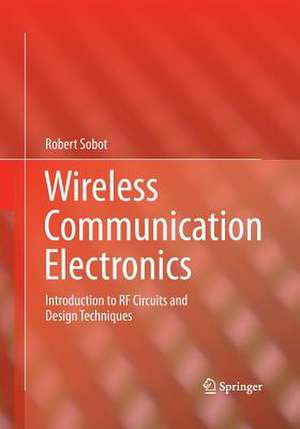Wireless Communication Electronics: Introduction to RF Circuits and Design Techniques
Autor Robert Soboten Limba Engleză Paperback – 23 aug 2016
| Toate formatele și edițiile | Preț | Express |
|---|---|---|
| Paperback (2) | 594.10 lei 6-8 săpt. | |
| Springer – 23 aug 2016 | 594.10 lei 6-8 săpt. | |
| Springer International Publishing – 25 sep 2021 | 602.42 lei 6-8 săpt. | |
| Hardback (1) | 752.25 lei 6-8 săpt. | |
| Springer International Publishing – 24 sep 2020 | 752.25 lei 6-8 săpt. |
Preț: 594.10 lei
Preț vechi: 698.94 lei
-15% Nou
113.70€ • 117.45$ • 94.62£
Carte tipărită la comandă
Livrare economică 25 martie-08 aprilie
Specificații
ISBN-10: 1493941534
Pagini: 386
Ilustrații: XVIII, 386 p.
Dimensiuni: 178 x 254 x 28 mm
Greutate: 0.7 kg
Ediția:Softcover reprint of the original 1st ed. 2012
Editura: Springer
Colecția Springer
Locul publicării:New York, NY, United States
Cuprins
Textul de pe ultima copertă
- Offers readers a complete, self-sufficient tutorial style textbook;
- Includes all relevant topics required to study and design an RF receiver in a consistent, coherent way with appropriate depth for a one-semester course;
- The labs and the book chapters are synchronized throughout a 13-week semester so that the students first study each sub-circuit and the related theory in class, practice problems, work out design details and then build and test the sub-circuit in the lab, before moving onto the next chapter;
- Includes detailed derivations of all key equations related to new concepts.
Caracteristici
Notă biografică
Robert Sobot received the B.Sc. degree in engineering physics from the University of Belgrade, ex-Yugoslavia, in 1989, and the M.A.Sc. and the Ph.D. degrees in electrical engineering from Simon Fraser University, Canada, in 1996 and 2005 respectively. In September 2014 he joined ENSEA in France as a Full Professor. From 2006 to 2015 he was with Western University in Canada as an Associate Professor, now he is an Adjunct Professor. From 1996 to 2001 he was with PMC-Sierra Inc., Canada, where he was leading projects in analog IC design. During 2012/14 he was invited researcher at the University Pierre et Marie Curie at Sorbonne (LiP6), Paris, France. Since 2010 he authored two textbooks on the topic of Wireless Communication Electronics, and he established the Implantable System Laboratory (ISL) at Western University in Canada that is dedicated to research related to wireless implantable telemetry systems.
Descriere
This book is intended for senior undergraduate and graduate students as well as practicing engineers who are involved in design and analysis of radio frequency (RF) circuits. Detailed tutorials are included on all major topics required to understand fundamental principles behind both the main sub-circuits required to design an RF transceiver and the whole communication system. Starting with review of fundamental principles in electromagnetic (EM) transmission and signal propagation, through detailed practical analysis of RF amplifier, mixer, modulator, demodulator, and oscillator circuit topologies, all the way to the basic system communication theory behind the RF transceiver operation, this book systematically covers all relevant aspects in a way that is suitable for a single semester university level course.
- Offers readers a complete, self-sufficient tutorial style textbook;
- Includes all relevant topics required to study and design an RF receiver in a consistent, coherent way with appropriate depth for a one-semester course;
- The labs and the book chapters are synchronized throughout a 13-week semester so that the students first study each sub-circuit and the related theory in class, practice problems, work out design details and then build and test the sub-circuit in the lab, before moving onto the next chapter;
- Includes detailed derivations of all key equations related to new concepts.
